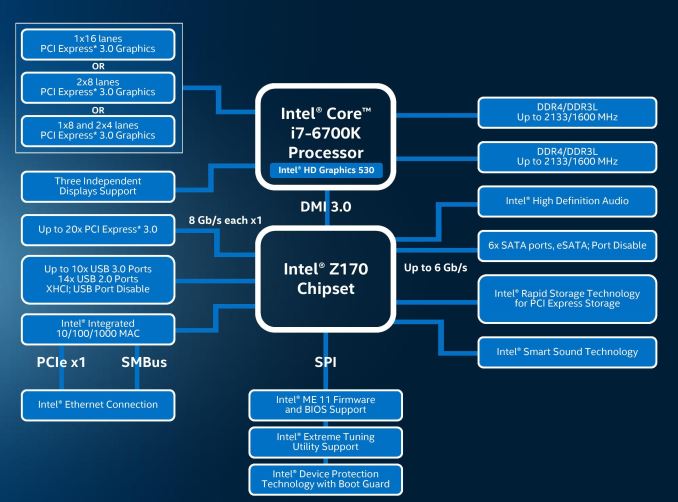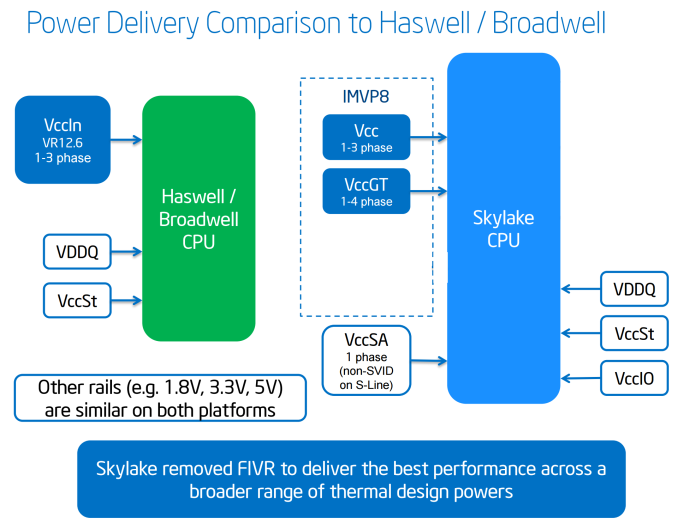The Intel 6th Gen Skylake Review: Core i7-6700K and i5-6600K Tested
by Ian Cutress on August 5, 2015 8:00 AM ESTThe Skylake CPU Architecture
As with any new Intel architecture, the devil is in the details. Previously at AnandTech we have been able to provide deep dives into what exactly is going on in the belly of the beast, although the launch of Skylake has posed a fair share of problems.
Nominally we rely on a certain amount of openness from the processor/SoC manufacturer in providing low level details that we can verify and/or explain. In the past, this information has typically been provided in advance of the launch by way of several meetings/consultations with discussions talking to the engineers. There are some things we can probe, but others are like a black box. The black box nature of some elements, such as Qualcomm’s Adreno graphics, means that it will remain a mystery until Pandora’s box is opened.
In the lead up to the launch of Intel’s Skylake platform, architecture details have been both thin on the ground and thin in the air, even when it comes down to fundamental details about the EU counts of the integrated graphics, or explanations regarding the change in processor naming scheme. In almost all circumstances, we’ve been told to wait until Intel’s Developer Forum in mid-August for the main reason that the launch today is not the full stack Skylake launch, which will take place later in the quarter. Both Ryan and I will be at IDF taking fastidious notes and asking questions for everyone, but at this point in time a good portion of our analysis comes from information provided by sources other than Intel, and while we trust it, we can't fully verify it as we normally would.
As a result, the details on the following few pages have been formed through investigation, discussion and collaboration outside the normal channels, and may be updated as more information is discovered or confirmed. Some of this information is mirrored in our other coverage in order to offer a complete picture in each article as well. After IDF we plan to put together a more detailed architecture piece as a fundamental block in analyzing our end results.
The CPU
As bad as it sounds, the best image of the underlying processor architecture is the block diagram:
From a CPU connectivity standpoint, we discussed the DDR3L/DDR4 dual memory controller design on the previous page so we won’t go over it again here. On the PCI-Express Graphics allocation side, the Skylake processors will have sixteen PCIe 3.0 lanes to use for directly attached devices to the processor, similar to Intel's previous generation processors. These can be split into a single PCIe 3.0 x16, x8/x8 or x8/x4/x4 with basic motherboard design. (Note that this is different to early reports of Skylake having 20 PCIe 3.0 lanes for GPUs. It does not.)
With this, SLI will work up to x8/x8. If a motherboard supports x8/x4/x4 and a PCIe card is placed into that bottom slot, SLI will not work because only one GPU will have eight lanes. NVIDIA requires a minimum of PCIe x8 in order to enable SLI. Crossfire has no such limitation, which makes the possible configurations interesting. Below we discuss that the chipset has 20 (!) PCIe 3.0 lanes to use in five sets of four lanes, and these could be used for graphics cards as well. That means a motherboard can support x8/x8 from the CPU and PCIe 3.0 x4 from the chipset and end up with either dual-SLI or tri-CFX enabled when all the slots are populated.
DMI 3.0
The processor is connected to the chipset by the four-lane DMI 3.0 interface. The DMI 3.0 protocol is an upgrade over the previous generation which used DMI 2.0 – this upgrade boosts the speed from 5.0 GT/s (2GB/sec) to 8.0 GT/s (~3.93GB/sec), essentially upgrading DMI from PCIe 2 to PCIe 3, but requires the motherboard traces between the CPU and chipset to be shorter (7 inches rather than 8 inches) in order to maintain signal speed and integrity. This also allows one of the biggest upgrades to the system, chipset connectivity, as shown below in the HSIO section.
CPU Power Arrangements
Moving on to power arrangements, with Skylake the situation changes as compared to Haswell. Prior to Haswell, voltage regulation was performed by the motherboard and the right voltages were then put into the processor. This was deemed inefficient for power consumption, and for the Haswell/Broadwell processors Intel decided to create a fully integrated voltage regulator (FIVR) in order to reduce motherboard cost and reduce power consumption. This had an unintended side-effect – while it was more efficient (good for mobile platforms), it also acted as a source of heat generation inside the CPU with high frequencies. As a result, overclocking was limited by temperatures and the quality of the FIVR led to a large variation in results. For Skylake on the desktop, the voltage regulation is moved back into the hands of the motherboard manufacturers. This should allow for cooler processors depending on how the silicon works, but it will result in slightly more expensive motherboards.
A slight indication of this will be that some motherboards will go back to having a large amount of multiplexed phases on the motherboard, and it will allow some manufacturers to use this as a differentiating point, although the usefulness of such a design is sometimes questionable.












477 Comments
View All Comments
SuperVeloce - Saturday, August 8, 2015 - link
Wait, what? Skylake and 2011-3 in the same sentence? Who, for the love of god, would say such a thing? Power delivery is (again) new and very different from Haswell/Broadwell, so there is no chance to reuse 1150 and 2011-3Oxford Guy - Saturday, August 8, 2015 - link
The belief put forward was that Broadwell would be compatible with Haswell desktop motherboards and Skylake would be compatible with Haswell-E motherboards.KAlmquist - Saturday, August 8, 2015 - link
The analysis by Puget Sound Systems offers a plausible explanation of why Skylake has a higher TDP than Haswell or Ivy Bridge: the integrated GPU that comes with Skylake is faster and draws more power. It appears that if you don't use the integrated GPU, Skylake draws slightly less power than Haswell.SuperVeloce - Saturday, August 8, 2015 - link
That's definitely plausible. The other thing here is the TDP 4790K uses. 88W is too conservative for the clocks and voltages from that chip. They needed to up that I am sure.bobbozzo - Saturday, August 8, 2015 - link
Error in graph on final page:"Gains over Sandy Bridge.png" - the key for green says IVY bridge.
tuklap - Saturday, August 8, 2015 - link
I don't know... Intel seems to keep pushing forwards every year with profit in mind. The thing that they are really making breakthrough is the non volatile, high bandwidth memory or Xpoint...If Xpoint will be available maybe this will give a new speed bump... But Sandy-Skylake is really good...
wizyy - Saturday, August 8, 2015 - link
There is a review which shows 6600k to be quite a nice improvement over popular I5 processors in 10 recent games, over at eurogamer.net. Check it if you're a gamer thinking to upgrade your older I5.SilverManSachs - Saturday, August 8, 2015 - link
There is a good jump in IPC for the Core i5, less so for the Core i7. This makes sense as its harder to push the top end performance higher at smaller nodes but they did improve the i5 performance which is great as i5's are the most sold parts. Also, good overclocking room on the i7.Would be very interested to see 'Skylake vs Excavator' CPU only benchmarks on the mobile 17W parts. Please so that test for us AT!
soldier45 - Sunday, August 9, 2015 - link
Spending $500+ on Skylake over my 2600k to get 3-5 fps in my games isn't really worth it. Having said that at the end of the day,I'm about to spend $700 on a 980Ti over a 780 classified so yeh I will end up going with Skylake.asmian - Sunday, August 9, 2015 - link
The interesting fact for me faced with building a new rig is how the i7-6700K compares with the 28-lane Haswell-E i7-5820K. For my usage (design/programming, no interest in SLI/Crossfire, regular Handbrake use), with very comparable mid-range boards (ASRock Z170 Extreme6+ versus ASRock X99 Extreme4 with the USB 3.1 A/C card) the price of mobo + board is almost identical at £490 or so in the UK right now - in fact, the Haswell-E combo would be £15 cheaper. All other added components (DDR4 memory, new OS, M2 SSD etc.) would be identical.So do the extra 2 cores at a somewhat lower eventual overclock for that Handbrake usage make up for extremely marginal extra IPC on 4 cores at a higher price (and trading a few extra features for many less SATA ports)? Somehow I doubt it... The only question remaining would be whether waiting another year or more for Skylake-E would be worth it for even more chipset features over X99, but that looks rather marginal as well.